The modern farmhouse look in interior design explained, with 7 easy ways to get it right
Modern farmhouse is a little bit minimal and a little bit country. Our experts decode this movement in modern interior design
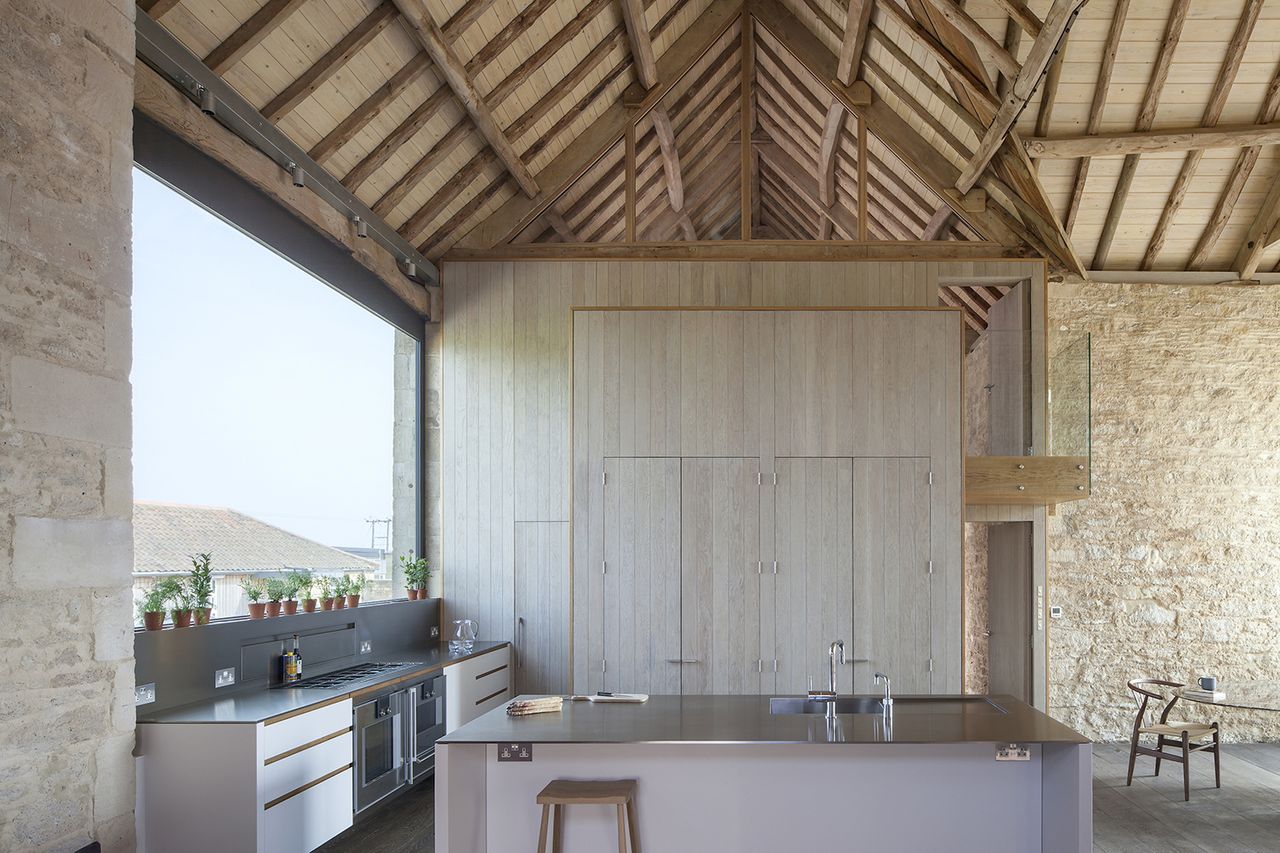
The modern farmhouse look is relevant to all areas of interior design. Whether you’re living in the city, country or suburbs, there’s little (read: no) chance that you missed the surge of contemporary rustic style. The humble aesthetic's trademarks (like white shiplap walls and wide plank floors) swept across the United States in less than a quick decade – even in places where proper farmhouses were nowhere to be found.
The clean and countrified look became popular, in part, because it’s well within reach. It's known for inexpensive materials and “weathered” furniture that’s far from precious (even better if it was pre-scuffed from a local flea market). And while the aesthetic's rise benefited from timing (more on that below), it struck a nostalgic chord with its local audience.
“I do think farmhouses are a major part of the American vernacular, and that history makes them immediately familiar and relatable to a lot of homeowners,” says New York designer Robert Stilin, who modelled his own home after a barn about two decades ago. “There’s also a humbleness and simplicity in the design of farmhouses that really lends itself to comfortable, easy living. I imagine a lot of homeowners find themselves especially attracted to that as well.”
And while the modern farmhouse style has waned lately, it remains an important influence on relaxed, contemporary interiors. Here’s everything you need to know.

Keith is an experienced homes writer and editor. He has written hundreds of articles for various international titles helping readers make the best home design choices, and spends his days interviewing interiors industry experts to bring the latest ideas to his readers. For this piece he spoke to the world's best designers who specialize in the modern farmhouse aesthetic to compile a comprehensive guide to this look.
Modern farmhouse in interior design explained
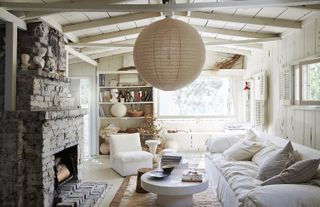
What is modern farmhouse style?
A contemporary spin on country style with traces of minimalist interior design (think spare rooms and white paint on walls), modern farmhouse blends rustic decor and nods to the “shabby chic” era but with cleaner lines. The aesthetic is a relaxed and low-fuss approach to interior design, with palpable warmth.
“I think the attractive and also important thing about farmhouse style is that it possesses a sense of authenticity – meaning to me, that the materials and vibe has to resonate as true,” says Alabama architect Jeffrey Dungan.
Certainly, you could characterize the modern farmhouse aesthetic as a notedly humble approach to design; the look spotlights the honest materials of simpler times, and champions DIY updates modest homeowners can accomplish with their own hands. Modern farmhouse dining rooms, for example, need be just a careworn table and simple adornments.
Be The First To Know
The Livingetc newsletter is your shortcut to the now and the next in home design. Subscribe today to receive a stunning free 200-page book of the best homes from around the world.
Where did the modern farmhouse look come from?
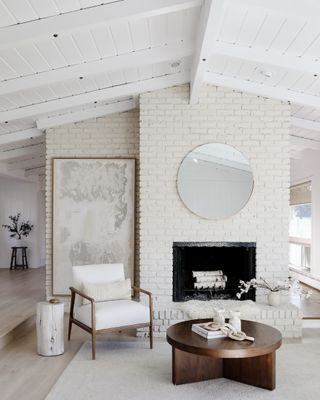
While the style nods to early American farmhouses, which were spare for practical reasons, modern farmhouse became one of the biggest interior design trends within the past decade.
“I think the modern farmhouse style started because people were actually fixing up old farmhouses with modern materials and then it started to resonate with other homeowners because it has the warmth and charm of vintage features and the livability of modern amenities,” says designer Leanne Ford, one of the movement’s early stars.
Any history of modern farmhouse’s rise would be remiss to leave out Chip and Joanna Gaines, who rose in fame after the 2008 housing crash. As HGTV stars, they mainstreamed the humble modern farmhouse style by way of their show, ‘Fixer Upper,’ which debuted in 2013. The affable duo popularized an unmistakable and easy-to-execute formula - like the addition of shiplap walls - that became ubiquitous throughout modern home renovations in the United States.
Does that mean that the entire aesthetic was souped up on cable TV? Not necessarily. The bedrock of the movement still finds roots in places where farmhouses really are part of the landscape.
"The modern farmhouse and modern barn trend emerged about ten years ago - though we didn’t necessarily see it as a trend at that time,” says interior designer Michael Del Piero, noting the style’s strong presence in regions with a history with agriculture. “We find that our clients in the Hamptons have embraced the aesthetic, as barns and farmhouses are plentiful here and an updated version seems fitting. The open, light-filled spaces are a wonderful backdrop for mixing modern elements with more classical pieces, and the generally neutral tones allow us to layer textures and styles.”
What does a modern farmhouse space look like?

Modern farmhouse interiors are awash in white walls, wide-plank floors, and reclaimed materials. In architecture, you don’t need an actual farmhouse to inhabit this trend – but if you’re starting from scratch, there are some key elements to the design.
If you had to pick one of the most popular fixtures of modern farmhouse style, it’s the ever-so-timeless farmhouse sink, a staple of rustic kitchen ideas. “When it comes to the latest kitchen trends, there's no doubt that the farmhouse, or apron sink, is one of the most popular choices for the modern farmhouse aesthetic,” says Lauren Williams of Washington DC’s MV Architects.
Like in transitional style, you’ll also find an emphasis on repurposed spaces, like the mudroom, somewhat of a luxury for homeowners who don’t necessarily work the fields. “I think farmhouse style mudroom entries are popular not only because they are charming, but because they are functional,” says Sondra Zabroske, an architect at DC's design-build firm Four Brothers. “Although it’s been a recent trend to strive to be minimalist, as Americans we tend to have a lot of stuff, and if you don’t create a home for your things, you’ll end up with a pile of coats on your kitchen table.”
And yet minimalist ideas are certainly a feature in modern farmhouse interiors, often with open layouts, neutral (if not white) color schemes, spare (but not too spare) rooms, and a mix of new and old furniture.
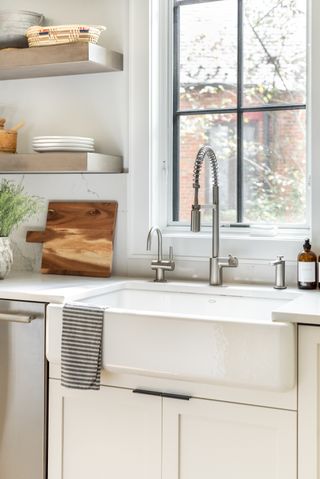
WHAT'S NEW IN MODERN FARMHOUSE STYLE?
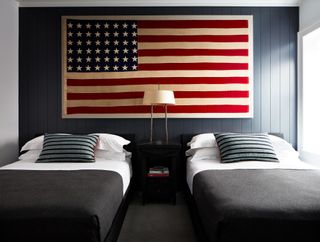
Of course, the modern farmhouse aesthetic that was popularized on television was bound to have hurdles – the sheer popularity has recently received pushback, with many figures within the industry claiming the movement is out of style. Still, the aesthetic's core elements continue to resonate and adapt. There is now a rise in farmhouse bedrooms as a way to create a relaxed environment to aid sleep.
"It’s become a phenomenon, though, and we’re seeing changes to the style," says interior designer Michael Del Piero. "The materials have evolved (less shiplap, perhaps) and the style itself feels much broader."
You'll find that farmhouse-inspired interiors today embrace a touch more color, often updating the signature white shiplap walls with a bold shade, or pulling together farmhouse living rooms with upmarket furniture and even a modern farmhouse fireplace.
“I think that the evolution of the ‘farmhouse style’ has developed primarily through the process of modernization: the introduction of more refined details, newer materials, and contemporary comforts,” says Robert Stilin. “Of course, in a modern farmhouse, all of these sophisticated touchstones are interacting with an architectural vernacular that enjoys a very storied past. So it’s really a play between the old and the new that has helped the Modern Farmhouse style mature into what it is now.”
How to get the modern farmhouse look right
1. Take inspiration from barns
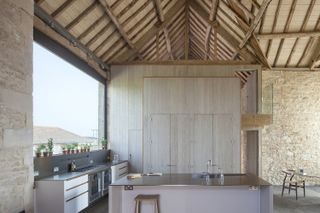
From the size of them, to the shape of them, to the very barn-ness of them, it;s this vibe that architects are now trying to recreate. Exposed superstructures, high ceilings, open-plan kitchen layouts ideal for large-scale entertaining, and vast windows capturing vistas of landscape and sky. This minimal reimagining of the farmhouse kitchen celebrates exposed trusses and beams, abundant wood, soaring ceilings and reclaimed materials.
And as with the best barns, a minimal approach is best - to keep the emphasis on the sense of space, not the stuff that's in it. And this works even if you're decorating a small kitchen.
'We kept the kitchen design as clean and pared-back as possible,' says Jack Trench founder of Jack Trench Bespoke Kitchens & Furniture. 'So as not to detract from the barn’s stonework and original roof beams.'
2. Pair old and new
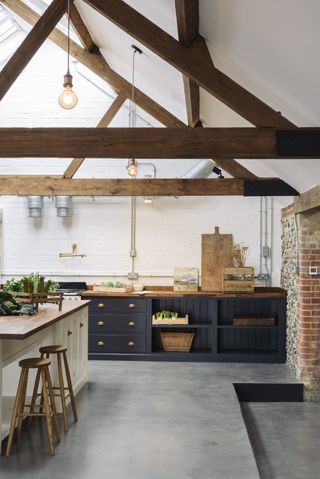
It's a myth that the the farmhouse vibe is all rustic. This contemporary take blends industrial elements, too. Take this kitchen by deVOL, which couldn't feel more classic farmhouse if it tried - the Shaker-style cabinets are pure country home.
What modernizes it is the pairing of the concrete flooring.
‘The kitchen has the ability to feel both industrial and a little bit country chic,’ says deVOL’s creative director Helen Parker of the space, which offsets more traditional elements with a polished concrete floor. ‘It’s the mix of concrete, brick walls and soft tones in the wooden worktops and copper sink that make this kitchen such a clever combination.’
3. Add a little flounce of linen
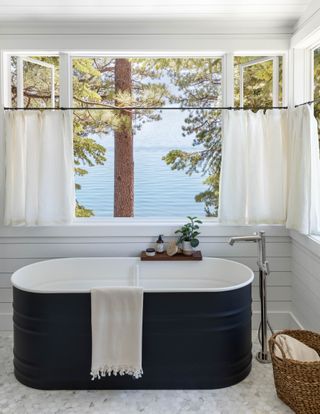
Cafe curtains are becoming a bathroom trend in their own right, bolstered by the rise in modern farmhouse design. It's the little ruffle of material that nods to rustic sensibilities, adding a prettiness to a functional space.
This bathroom was created by the Californian studio Jute Home, and the cafe curtains also serve to not block out the view entirely. ‘The tub is the perfect location to relax and enjoy the view of the lake or falling snow during the winter months,' says Jute's Ali Davin.
4. Use Venetian plaster
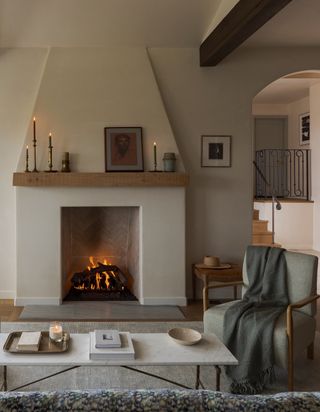
White Venetian plaster is the ideal farmhouse material - it has a slight polish to it that lends a real feeling of texture, adding warmth and rustic homeliness. It pairs well with rough wood, as seen here in this living room designed by Lisa Koch.
A simple timber mantelpiece completes the fireplace hearth. ‘The mantle is made from a fallen native cypress tree. We decided to keep it raw and look forward to seeing it patinate over time,' says homeowner Dev Patel.
5. Keep wood looking untreated
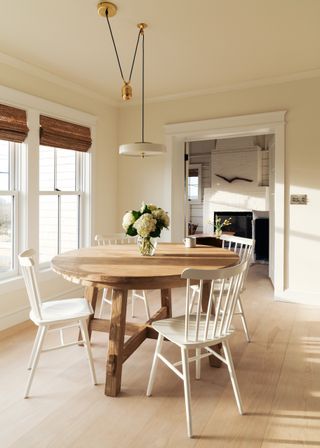
The rougher the end of the wood, the more of a modern farmhouse vibe it creates. So, for a dining room table, it helps if the legs are knotted rather than smooth or - as seen in the fireplace in the point about Venetian plaster, if the hearth has it whorls fully on display.
6. Salvage what you can

Another neat trick for injecting modern farmhoue style into a home is to make it feel careworn, curated, and like it has been lived in a long time. This can easily be done by choosing an edited selection from salavage. ‘This cabin looks older now than when I got my hands on it,’ says interior designer Leanne Ford of the 1900s timber home she restored in Los Angeles. ‘The area where this bedroom is was once outside, but we extended these little rooms to make it part of the interior,’ adds the designer, who retained an indoor-outdoor feel with stone flooring and a rustic aesthetic.
‘I found these gorgeous old glazed doors and hung them on barn slide behind the bed, then painted them to help them blend in,’ she continues. ‘I love white paint in all shades, but bright white would have been too modern in here, so I used a really warm, antique shade of white to match the cabin.’
7. Stick to a simple palette
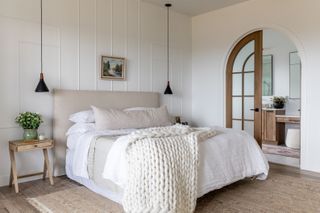
Sticking to a neutral palette of whites, creams, beiges and woods not only feels restfully farmhouse but also will give your scheme longevity. The key is to start with quite a simple base and add in those farmhouse feels with the furniture and accessories.
'Our client showed us an inspirational image with a very distinct wall treatment. The wall design was very graphic with straight lines and hard angles. We wanted to balance that out with soft linens and curved furniture.' explains Kirsten Krason Co-Owner of House of Jade, designer of this farmhouse bedroom.
'The headboard is all linen. It’s very simple and it lets our intricate wall detail shine. We wanted the nightstands to have a “found” quality so we did mismatched pieces but they are tied together with the wood finish. Our favorite thing about the bed and the bedding is that it can still be beautiful even if it’s not made. Everything looks heavenly and cozy even if the sheets aren’t perfectly straight!'
Keith Flanagan is a New York based journalist specialising in design, food and travel. He has been an editor at Time Out New York, and has written for such publications as Architectural Digest, Conde Nast Traveller, Food 52 and USA Today. He regularly contributes to Livingetc, reporting on design trends and offering insight from the biggest names in the US. His intelligent approach to interiors also sees him as an expert in explaining the different disciplines in design.
-
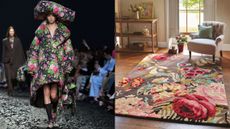 Florals *Can* be Groundbreaking, and This Unlikely Collaboration Proves How
Florals *Can* be Groundbreaking, and This Unlikely Collaboration Proves HowItalian fashion house, Moschino, tapped Sanderson’s iconic floral archive for its latest show in Milan
By Julia Demer Published
-
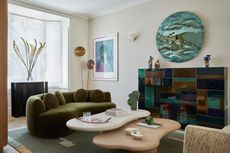 The "One Amazing Thing" Theory Could Just Be the Secret to Making Your Decorating Budget Go Further (While Making More Impact)
The "One Amazing Thing" Theory Could Just Be the Secret to Making Your Decorating Budget Go Further (While Making More Impact)What if we told you designers had found a way to control a project's spend even while elevating the final result? This new trend does just that
By Pip Rich Published